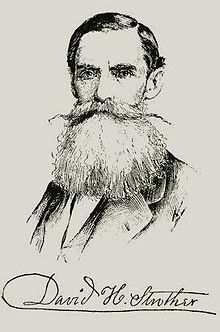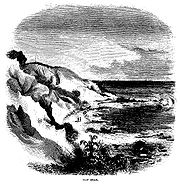- David Hunter Strother
-
David Hunter Strother (September 26, 1816 – March 8, 1888) was a successful 19th century American magazine illustrator and writer, popularly known by his pseudonym, "Porte Crayon" (French, Porteur crayon: "Pencil Carrier").
Contents
Biography
Early life
Strother was born in Martinsburg, Virginia (now West Virginia). He studied drawing under Pietro Aneora in Philadelphia, Pennsylvania, from 1829 to 1836 when he became a student of Samuel F. B. Morse in New York. He went west in 1838, travelling through the United States, and in 1840 visited Europe, remaining five years. On his return he settled in New York, where, under the direction of John G. Chapman, he acquired the art of drawing on wood for the engravers. In 1848 he returned to his native place, and four years later published, under the pen-name of “Porte Crayon”, the first of his series of papers in Harper's Monthly. Strother was an artist for The Crayon, the leading art journal of the United States at the time, and a frequent contributor to Harper's Monthly. Most of his early work was landscapes and other outdoor scenes. His art pertained mostly to Virginia and the Southern United States. Prior to the American Civil War, his art was published in books titled The Blackwater Chronicle (1853) and Virginia Illustrated (1857).
Civil War
Despite his Virginia upbringing, Strother supported the Union during the Civil War. Upon the war's outbreak, Strother was commissioned by the U.S. Army and assigned as a topographer due to his detailed knowledge of the Shenandoah Valley. During this time, Strother recorded his experiences in the war, which he would later publish in Harper's Monthly as "Personal Recollections of the War." His accounts are considered to be unique and are highly praised for their objective viewpoint. On June 12th, 1864, Col. Strother was chief of staff to his cousin General David Hunter, and was involved in the shelling and burning of the Virginia Military Institute (VMI). He was promoted colonel of the 3rd West Virginia Cavalry and involved in 30 battles, though never wounded, and was appointed a brevet brigadier general in 1865. Following the war, he was Adjutant General of the Virginia Militia and a member of the VMI Board of Visitors; in that capacity he actively promoted the reconstruction of VMI.
Postbellum career
After the war, topics of Strother's pieces covered a wider range of subjects. He began to make works that commented on politics and race relations, including a sketched portrait of Chief Sitting Bull. Some of his drawings were merely of individuals and groups going about their daily lives.
Strother ended his career as an artist when he was appointed by President Rutherford B. Hayes to be the General Consul to Mexico City in 1879. He returned to West Virginia in 1885 and died there three years later. The New York Times published an obituary in which it is stated that his name was a household one during his career. Strother is buried in Green Hill Cemetery in Martinsburg, West Virginia.
Works
- Kennedy, Philip Pendleton (1853), The Blackwater Chronicle, A Narrative of an Expedition into the Land of Canaan in Randolph County, Virginia, Redfield, New York; Illustrated by David Hunter Strother.
- Strother, David Hunter (1853), "The Virginia Canaan", Harper's Magazine, 8:18-36.
- Strother, David Hunter (1857), Virginia Illustrated, containing "A Visit to the Virginian Canaan" and "The Adventures of Porte Crayon and his Cousins"; New York: Harper & Brothers, Publishers
- Strother, David Hunter (1872-73), "The Mountains", Harper's New Monthly Magazine, v. 44-51. A fictionalized travelogue based on actual experiences in the mountains of West Virginia.
- Strother, David Hunter (18??), "The Old South Illustrated", edited with introduction by Cecil B. Eby, Jr, University of North Carolina Press, 1959.
- Strother, David Hunter (1961), Virginia Yankee in the Civil War: The Diaries of David Hunter Strother; Edited by Cecil D. Eby, University of North Carolina Press.
- Strother, David Hunter (2006), Porte Crayon's Mexico: David Hunter Strother's Diaries in the Early Porfirian Era, 1879-1885, Edited by John E. Stealey III, Kent State University Press.
Legacy
- Mount Porte Crayon, in eastern West Virginia, is named from Strother's pseudonym.
- A noted folk painting, Meditation by the Sea (ca. 1862), is based on a Strother engraving.
See also
- Sinks of Gandy
- Seneca Rocks
- Canaan Valley
- Blackwater Falls
References
- Eby, Jr., Cecil D. (1960), "Porte Crayon": The Life of David Hunter Strother, University of North Carolina Press.
 "Strother, David Hunter". Appletons' Cyclopædia of American Biography. 1900.
"Strother, David Hunter". Appletons' Cyclopædia of American Biography. 1900.
External links
Categories:- People from Martinsburg, West Virginia
- American illustrators
- 1816 births
- 1888 deaths
Wikimedia Foundation. 2010.


